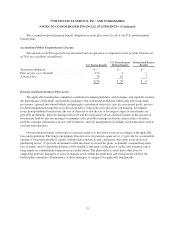UPS 2009 Annual Report Download - page 97
Download and view the complete annual report
Please find page 97 of the 2009 UPS annual report below. You can navigate through the pages in the report by either clicking on the pages listed below, or by using the keyword search tool below to find specific information within the annual report.UNITED PARCEL SERVICE, INC. AND SUBSIDIARIES
NOTES TO CONSOLIDATED FINANCIAL STATEMENTS—(Continued)
default swap spread, subject to certain minimum rates and maximum rates based on our public debt ratings from
Standard & Poor’s and Moody’s. If our public debt ratings are A / A2 or above, the minimum applicable margin
is 1.00% and the maximum applicable margin is 2.00%; if our public debt ratings are lower than A / A2, the
minimum applicable margin is 1.50% and the maximum applicable margin is 3.00%.
The second agreement provides revolving credit facilities of $1.0 billion, and expires on April 19, 2012.
Interest on any amounts we borrow under this facility would be charged at 90-day LIBOR plus 15 basis points.
At December 31, 2009, there were no outstanding borrowings under either of these facilities.
In addition to these credit facilities, we have an automatically effective registration statement on Form S-3
filed with the SEC that is available for registered offerings of short or long-term debt securities.
Our existing debt instruments and credit facilities do not have cross-default or ratings triggers, however
these debt instruments and credit facilities do subject us to certain financial covenants. As of December 31, 2009
and for all prior periods presented, we have satisfied these financial covenants. These covenants limit the amount
of secured indebtedness that we may incur, and limit the amount of attributable debt in sale-leaseback
transactions, to 10% of net tangible assets. As of December 31, 2009, 10% of net tangible assets is equivalent to
$2.296 billion, however we have no covered sale-leaseback transactions or secured indebtedness outstanding.
Additionally, we are required to maintain a minimum net worth, as defined, of $5.0 billion on a quarterly basis.
As of December 31, 2009, our net worth, as defined, was equivalent to $12.757 billion. We do not expect these
covenants to have a material impact on our financial condition or liquidity.
Fair Value of Debt
Based on the borrowing rates currently available to the Company for long-term debt with similar terms and
maturities, the fair value of long-term debt, including current maturities, is approximately $10.216 and $10.287
billion as of December 31, 2009 and 2008, respectively.
NOTE 8. LEGAL PROCEEDINGS AND CONTINGENCIES
We are a defendant in a number of lawsuits filed in state and federal courts containing various class-action
allegations under state wage-and-hour laws. In one of these cases, Marlo v. UPS, which was certified as a class
action in a California federal court in September 2004, plaintiffs allege that they improperly were denied
overtime, and seek penalties for missed meal and rest periods, and interest and attorneys’ fees. Plaintiffs purport
to represent a class of 1,300 full-time supervisors. In August 2005, the court granted summary judgment in favor
of UPS on all claims, and plaintiffs appealed the ruling. In October 2007, the appeals court reversed the lower
court’s ruling. In April 2008, the Court decertified the class and vacated the trial scheduled for that month. We
have denied any liability with respect to these claims and intend to vigorously defend ourselves in this case. At
this time, we have not determined the amount of any liability that may result from this matter or whether such
liability, if any, would have a material adverse effect on our financial condition, results of operations, or
liquidity.
In another case, Hohider v. UPS, which in July 2007 was certified as a class action in a Pennsylvania federal
court, plaintiffs have challenged certain aspects of the Company’s interactive process for assessing requests for
reasonable accommodation under the Americans with Disabilities Act. Plaintiffs purport to represent a class of
over 35,000 current and former employees, and seek back-pay, and compensatory and punitive damages, as well
as attorneys’ fees. In August 2007, the Third Circuit Court of Appeals granted our petition to hear the appeal of
the trial court’s certification order. In July 2009, the Third Circuit issued its decision decertifying the class and
85
























